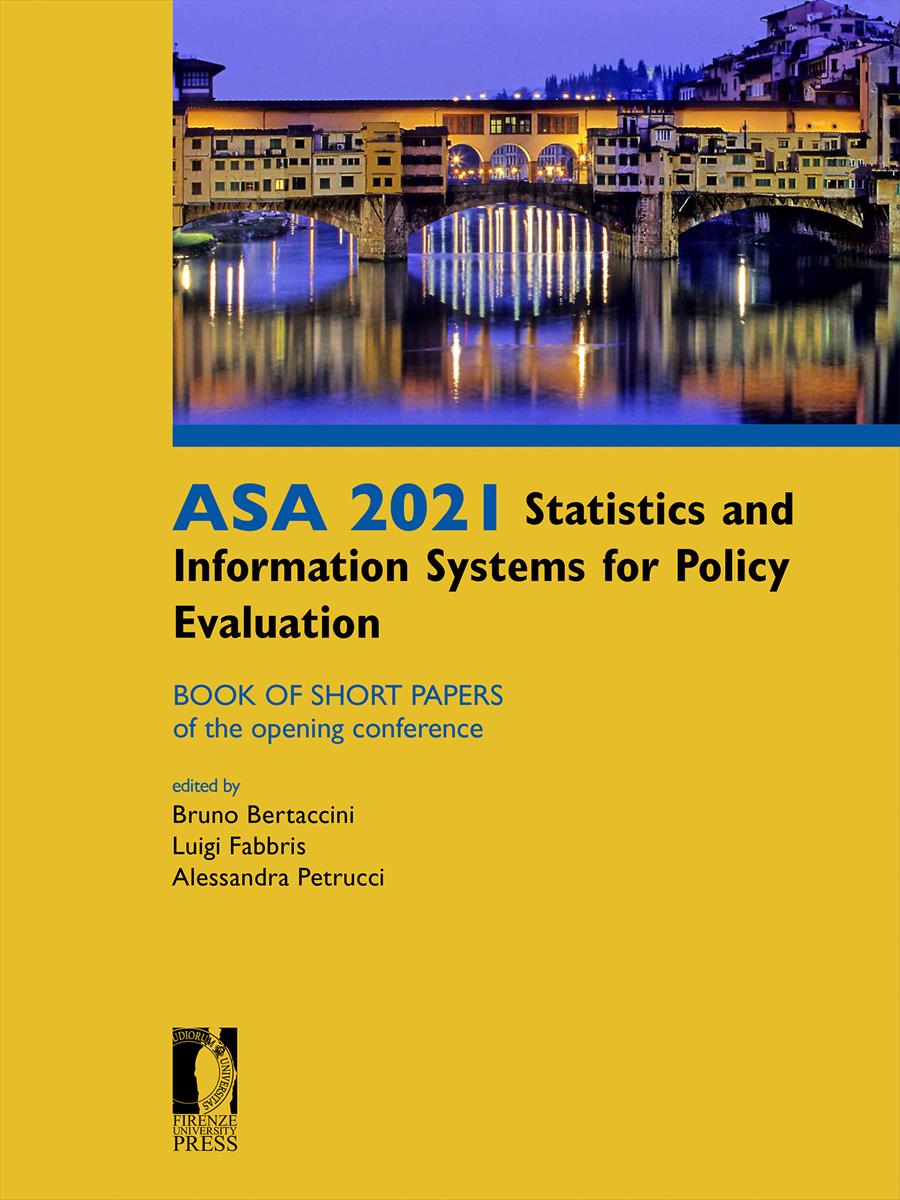- ASA 2021 Statistics and Information Systems for Policy Evaluation
- Edited by Bruno Bertaccini, Luigi Fabbris, Alessandra Petrucci
Using eye-tracking to evaluate the viewing behavior on tourist landscapes
- Gianpaolo Zammarchi
- Giulia Contu
- Luca Frigau
- © 2021 Author(s) |
- CC BY 4.0
- DOI: 10.36253/978-88-5518-304-8.28
Every tourist website employs images to attract potential tourists. In particular, destination tourism websites use environmental images, such as landscapes, to attract the attention of tourists and to address their purchase choice. Nowadays the effectiveness of these tools has been enhanced by the use of eye-tracking technology. That allows measuring the exact eye position during the visualization of images, texts, or other visual stimuli. Consequently, eye-tracking data can be processed to obtain quantitative measures of viewing behavior that can be analyzed for several purposes in many fields such as to cluster consumers, to improve the effectiveness of a website and for neuroscience studies. This work is aimed to use eye-tracking technology to investigate user behavior according to different types of images (e.g. natural landscapes, city landscapes). Specifically, we compare different statistical descriptive tools with supervised and unsupervised models. Furthermore, we discuss the effectiveness of their results and their capacity to provide satisfactory and interpretable solutions that can be used by decision-makers.
- Keywords:
- Tourism,
- Eye-tracking,
- Fixations,
University of Cagliari, Italy - ORCID: 0000-0002-9733-380X
University of Cagliari, Italy - ORCID: 0000-0001-9750-1896
University of Cagliari, Italy - ORCID: 0000-0002-6316-4040
- Busswell, G.T. (1935). How people look at pictures: A study of the psychology of perception in art. University of Chicago Press, Chicago, (US).
- Dupont, L., Antrop, M., Van Eetvelde, V. (2013). Eye-tracking analysis in landscape perception research: influence of photograph properties and landscape characteristics. Landscape Research, 39(4), pp. 1-18.
- Garín-Muñoz, T., Amaral, T. (2011). Internet Usage for Travel and Tourism. The Case of Spain. Tourism Economics, 17, pp. 1071-1085.
- Itti, L. (2004). Automatic foveation for video compression using a neurobiological model of visual attention. IEEE Transactions on Image Processing, 13, pp. 1304–1318.
- Jiménez-García, M., Ruiz-Chico, J., Peña-Sánchez, A.R. (2020). Landscape and Tourism: Evolution of Research Topics. Land, 9(12), pp. 1-17.
- Judd, T., Ehinger, K., Durand, F., Torralba, A. (2009). Learning to Predict where Humans Look. ICCV 2009.
- Li, Q., Huang, Z., Christianson, K. (2016). Visual attention toward tourism photographs with text: An eyetracking Study. Tourism Management, 54, pp. 243-258.
- Mannan, S.K., Ruddock, K.H., Wooding, D.S. (1996). The relationship between the locations of spatial features and those of fixations made during visual examination of briefly presented images. Spatial Vision, 10, pp. 165–188.
- Parkhurst, D.J., Niebur, E. (2003). Scene content selected by active vision. Spatial Vision, 16, pp. 125–154.
- R Core Team. (2020). R: A language and environment for statistical computing. R Foundation for Statistical Computing, Vienna, Austria, (AT). URL https://www.R- project.org/.
- Ruhanen, L.M., McLennan, C.-L. J., Moyle, B.D. (2013). Strategic issues in the Australian tourism industry: A 10-year analysis of national strategies and plans. Asia Pacific Journal of Tourism Research, 18(3), pp. 220–240.
- Scott, N., Zhang, R., Le, D., Moyle, B. (2019) A review of eye-tracking research in tourism. Current Issues in Tourism, 22(10), pp. 1244-1261.
- Scrucca, L., Fop, M., Murphy, T.B., Raftery, A.E. (2016). mclust 5: clustering, classification and density estimation using Gaussian finite mixture models. The R Journal, 8(1), pp. 289– 317.
- Venables, W.N., Ripley, B.D. (2002). Modern Applied Statistics with S, Fourth edition. Springer, New York, (US). ISBN 0-387-95457-0.
- Wang, Y., Sparks, B.A. (2016). An Eye-Tracking Study of Tourism Photo Stimuli: Image Characteristics and Ethnicity. Journal of Travel Research, 55(5), pp. 588-602.
- Wickham, H. (2009). ggplot2: Elegant Graphics for Data Analysis. Springer-Verlag New York, New York, (US).
- WTTC, GLOBAL ECONOMIC IMPACT & TRENDS 2020. https://wttc.org/Research/Economic- Impact/moduleId/1445/itemId/91/controller/DownloadRequest/action/QuickDownload (12/20).
Chapter Information
Chapter Title
Using eye-tracking to evaluate the viewing behavior on tourist landscapes
Authors
Gianpaolo Zammarchi, Giulia Contu, Luca Frigau
Language
English
DOI
10.36253/978-88-5518-304-8.28
Peer Reviewed
Publication Year
2021
Copyright Information
© 2021 Author(s)
Content License
Metadata License
Bibliographic Information
Book Title
ASA 2021 Statistics and Information Systems for Policy Evaluation
Book Subtitle
Book of short papers of the opening conference
Editors
Bruno Bertaccini, Luigi Fabbris, Alessandra Petrucci
Peer Reviewed
Publication Year
2021
Copyright Information
© 2021 Author(s)
Content License
Metadata License
Publisher Name
Firenze University Press
DOI
10.36253/978-88-5518-304-8
eISBN (pdf)
978-88-5518-304-8
eISBN (xml)
978-88-5518-305-5
Series Title
Proceedings e report
Series ISSN
2704-601X
Series E-ISSN
2704-5846
